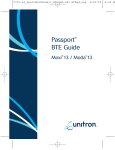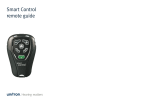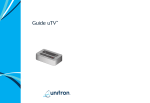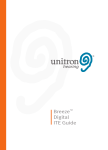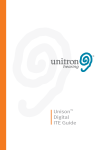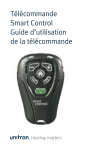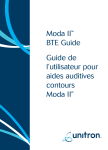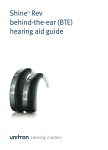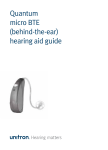Download Unitron Tandem Operating instructions
Transcript
Tandem™ Guide Table of Contents Your Tandem™ Hearing Instruments..............................1 Overview of your Tandem™ Hearing Instruments .........2 Features of your Tandem™ Hearing Instruments ..........6 Putting your Hearing Instruments on your Ears .............7 Turning your Hearing Instruments On and Off ..............9 Battery Information .......................................................11 Operating Instructions ..................................................13 Using the Telephone .....................................................16 Caring for your Hearing Instruments.............................18 Cleaning your Hearing Instruments ..............................19 Signature Features of your Tandem™ Hearing Instruments................................................................22 Noise Interference ........................................................23 Warnings.......................................................................24 Troubleshooting Guide .................................................28 Warning to Hearing Instrument Dispensers (to comply with the U.S. Food and Drug Administration (FDA) regulations)..............................31 Your Tandem™ Hearing Instruments Hearing Healthcare Professional: _______________________ __________________________________________________ Telephone: _________________________________________ Model: ____________________________________________ Serial Number:______________________________________ Replacement Batteries: Size 13 Warranty: __________________________________________ Program 1 is: automatic program (Tandem 16 only) manual program for: ___________________ Program 2 is the manual program for: __________________ Program 3 is the manual program for: __________________ Program 4 is the manual program for: __________________ Date of Purchase: ___________________________________ 1 Overview of your Tandem™ Hearing Instruments There are two parts to your Tandem™ system: • transmitter hearing instrument • receiver hearing instrument Transmitter Hearing Instrument The transmitter hearing instrument is labeled “Tandem Tx”. It is worn on your poor ear. The diagrams below identify some of the components of your transmitter hearing instrument. Have your hearing healthcare professional place a check beside the diagram that best describes your transmitter hearing instrument style and retention attachment. Transmitter Attachment Style (check one) Slim tube and dome Earmold Retainer earhook My transmitter hearing instrument has Volume control 2 2 3 1 8 4 2 5 6 3 4 7 Legend 1 Earhook 2 Microphone and Microphone Shield 3 Volume Control 4 Battery Door / On & Off Switch 5 Slim Tube 6 Dome 7 Retention piece 8 Earmold 3 Receiver Hearing Instrument There are two different receiver hearing instrument styles available. The diagrams below identify some of the components on your receiver hearing instrument. Have your hearing healthcare professional place a check beside the diagram that best describes your receiver hearing instrument style and attachment. Receiver Attachment Style (check one) Slim tube and dome Earmold My receiver hearing instrument has (check all that apply) Program Button Volume Control Optional Accessory Smart Control See Smart Control User Guide for more information. 4 2 3 4 1 9 5 2 3 6 7 4 5 8 Legend 1 Earhook 2 Microphone and Microphone Shield 3 Program button 4 Volume Control (optional) 5 Receiver Boot / Battery Door / On & Off Switch 6 Slim Tube 7 Dome 8 Retention piece 9 Earmold 5 Features of your Tandem™ Hearing Instruments Tandem™ hearing instruments come equipped with various advanced features, including: • CROS and BiCROS inputs • Automatic listening program plus 3 manual programs for Tandem 16 • 4 manual programs for Tandem 4 • Speech enhancement LD • AntiShock™ • Noise reduction It may take some time for you to fully adjust to your new hearing instruments. In the beginning, do not feel as though you need to wear them for longer than is comfortable. Depending on your previous experience with hearing instruments, increase wearing time gradually until you have fully adjusted to them. Eventually, you should wear your Tandem hearing instruments all day every day. Please consult your hearing healthcare professional regarding any adjustments you may require to ensure that you are happy with your hearing instruments. For instance, pitch and loudness of the beeps can be adjusted or turned off entirely. Also note that this is a general guide and your hearing healthcare professional may have enabled or disabled certain features depending on your requirements. 6 Putting your Hearing Instruments on your Ears Your behind-the-ear (BTE) hearing instruments may be color-coded red for your right ear and blue for your left ear. This color indicator is located on the battery door with a small colored dot. The transmitter hearing instrument is for your poor ear and the receiver hearing instrument with the receiver boot is for your better ear. BTEs with Earmolds 1. Hold the earmold between your thumb and index finger. The opening should be pointing in towards your ear canal with the BTE resting upwards near the top of your ear. Carefully insert the earmold in your ear. You may need to turn it slightly backwards. The earmold should fit into your ear snugly and comfortably. 2. Place the hearing instrument over the top of your ear. 7 BTEs with Slim Tubes 1. Hold the slim tube where it attaches to the dome and gently push the dome into your ear canal. The slim tube should lie flush against your head and not stick out. 2. Place the hearing instrument over the top of your ear. 3. Place the retention piece in your ear so it rests at the bottom of the opening of your ear canal. 8 Turning your Hearing Instruments On and Off Your hearing instruments have a three-position battery door or receiver boot that acts as the on/off switch and that allows access to the battery compartment. ON: To turn your transmitter hearing instrument on, close the battery door fully. To turn your receiver hearing instrument on, close the receiver boot fully. Note: It may take a few seconds before the hearing device turns on. Your hearing healthcare provider can additionally increase the start up delay if required. OFF: To turn your transmitter hearing instrument off, partially open the battery door. To turn your receiver hearing instrument off, partially open the receiver boot. This position allows excess moisture to vent away from the battery compartment. 9 Transmitter Hearing Instrument on off open Receiver Hearing Instrument on off open Note: When turning your hearing instruments on and off while they are on your ears, grasp the top and bottom of the device with your index finger and thumb. Use your thumbnail to open and close the battery door or receiver boot. 10 Battery Information Size 13 batteries are used in your Tandem hearing instruments. To replace the hearing instrument battery, fully open the battery door or receiver boot for access to the battery compartment. Low Battery Warning When you hear two long beeps, your hearing devices are warning you that their batteries are low. You will hear the warning approximately every 30 minutes until you change the batteries or the batteries die. After the first warning, you may experience some reduction in sound quality. This is normal and can be remedied by inserting fresh batteries into the hearing devices. If you prefer, your hearing healthcare professional can change the pitch and loudness of the low battery beep or turn it off entirely. Note: Replace the batteries in both the transmitter and receiver hearing instruments at the same time. Replacing the Battery 1. Gently swing out the battery door or receiver boot with your fingernail. 2. Grasp the battery with your thumb and index finger and remove. 11 3. Insert the new size 13 battery into the battery compartment with the plus (+) sign on the Plus (+) battery facing up, the Signs same way as the plus (+) sign on the edge of the battery door. This will ensure that the battery door closes properly. Note: If the battery is inserted incorrectly, the door will not close. 4. Close the battery door. Caring for Batteries • Always discard batteries in a safe and environmentally friendly way. • To prolong battery life, remember to turn your hearing devices off when not in use. • Remove the batteries and keep the battery door and receiver boot open while your hearing devices are not in use. This will allow internal moisture to evaporate. 12 Operating Instructions Volume Control Tandem™ receiver hearing instrument with volume control and push button Your Tandem receiver hearing instrument comes with two controls on the hearing instrument – a volume control and a push button. You can increase the loudness of your hearing instruments by turning up the volume control (scroll up). You can decrease the loudness of your hearing instruments by turning down the volume control (scroll down). Tandem™ receiver hearing instrument with push button only and optional Smart Control The optional remote control allows you to adjust your volume levels. Pressing the + button increases the loudness of your hearing instrument. Pressing the – button decreases the loudness of your hearing instrument. Please refer to the Smart Control User Guide for more information. Setting your Ideal Volume Your Tandem receiver hearing instrument has an ideal volume indicator. A single beep indicates when the volume control has reached its ideal level for your particular hearing abilities, as pre-set by your hearing healthcare professional. 13 Tandem™ transmitter hearing instrument with volume control Your Tandem transmitter hearing instrument has a volume control which only affects the sounds coming from the poor ear side. You can increase the loudness of sounds from your poor ear side by turning up the transmitter volume control (scroll up). You can decrease the loudness of sounds from your poor ear side by turning down the transmitter volume control (scroll down). Note: The transmitter volume control does not emit an ideal volume indicator. 14 Push Button Your receiver hearing instrument is equipped with a push button which enables you to switch between programs. Each time you push the button, you will move to a new program. Your hearing instruments beep to indicate which program you are in (i.e. one beep for program 1, two beeps for program 2, etc.). If you prefer, your hearing healthcare professional can change the pitch and loudness of the beeps or turn them off entirely. Program 1 (e.g. Automatic Program) 1 beep Program 2 (e.g. Group/Party Noise) 2 beeps Program 3 (e.g. Easy-t/Telephone) 3 beeps Program 4 (e.g. Music) 4 beeps Easy-t/Telephone short melody Your Tandem hearing instruments may also come with an optional remote control which allows you to switch between different listening programs. Please refer to the Smart Control User Guide for more information. 15 Using the Telephone As telephones do not all work the same, you may experience different results from different phones. You can use many phones by simply holding the receiver to your ear, without the need to change to a dedicated telephone program on your hearing instrument. Remember to move the handset slightly up or back to find the position that sounds best to you. Your hearing healthcare professional may have set up an automatic telephone program on your Tandem hearing instruments, called easy-t. Your hearing instrument will automatically switch to your dedicated telephone program when the telephone is brought up close to your receiver hearing instrument (better ear). When the telephone is moved away from the hearing instrument, it will automatically return to the previous listening program. This automatic switching relies on the magnet in your telephone ear piece. If the hearing instrument does not switch to the telephone program automatically when the telephone is placed close to your receiver hearing instrument, then the magnet in your telephone is not strong enough to trigger the automatic switching. Ask your hearing healthcare professional for an easy-t magnet and attach it to your telephone ear piece. 16 Consult your hearing healthcare professional if you experience difficulties using your hearing instruments on the phone. To affix the optional easy-t magnet: 1. Clean the telephone ear piece. 2. Hold the magnet near the “listening end” of your telephone and release it (Figure 1). The magnet will flip to the appropriate side and seek the optimal position on the telephone ear piece. 3. Place the double-sided tape in this optimal position on the telephone ear piece (Figure 2) and attach the magnet to the tape (Figure 3). Figure 1 Figure 2 Figure 3 17 Caring for your Hearing Instruments • Open the battery door and receiver boot when not in use. • Always remove your hearing instruments when using hair care products. The hearing instruments can become clogged and cease to function properly. • Do not wear your hearing instruments in the bath or shower or immerse them in water. • If your hearing instruments do become wet, do not attempt to dry them in an oven or microwave. Do not adjust any controls. Open the battery door or receiver boot immediately, and allow your hearing instruments to dry naturally for 24 hours. • Protect your hearing instruments from excessive heat (hair dryer, vehicle glove box or dashboard). • Regular use of a dehumidifier, such as a Dri-Aid kit, can help prevent corrosion and prolong the life of your hearing instruments. • Do not drop your hearing instruments or knock them against hard surfaces. 18 Cleaning your Hearing Instruments Ear wax is natural and common. Ensuring your hearing instruments are free of ear wax is an important step in your daily cleaning and maintenance routine. • Never use alcohol to clean your hearing devices, earmolds or domes. • Do not use sharp tools to dislodge ear wax. Sticking household items into your hearing devices or earmolds can seriously damage them. Tandem™ Hearing Instruments with Earmolds Earmolds send amplified sound from the hearing devices into the ears. They must fit into your ears snugly and comfortably. If amplified sound leaks out of your ear, you may hear whistling. Always ensure earmolds are clean and free of earwax. Do not use alcohol to clean your earmolds. If the earmolds become plugged, clear the opening with a wax loop or pipe cleaner. If your physician prescribes eardrops, clean any moisture that may get into the earmolds or tubing to prevent plugging. If the earmolds require further cleaning, disconnect the plastic tube from the earhook of the hearing devices. Wash only the earmolds in warm water with a 19 mild soap. Rinse them with cool water and allow them to dry overnight. Make sure the earmold tubes are dry before reconnecting them to each earhook on your hearing instrument. Tandem™ Hearing Instruments with Slim Tubes and Domes You should have the slim tubes and domes replaced by your hearing healthcare professional approximately every three to six months or when they become stiff, brittle, or discoloured. Clean the domes daily with a damp cloth. You should also clean the slim tubes periodically, with the cleaning pin provided, when you begin to notice debris in and around the tubes. 1. Hold the slim tube in one hand and the hearing instrument in the other hand. 2. Gently turn the hearing instrument counterclockwise until it detaches from the slim tube. 3. Use a damp cloth to clean the outside of the slim tube and dome. 4. Remove the dome from the slim tube before cleaning the slim tube. 20 5. Using the black cleaning pin provided in the kit, gently insert the cleaning pin where the slim tube attaches to the hearing instrument and push the pin all the way through the tube. Note: The slim tubes and domes should never be rinsed or submerged in water as water drops may become lodged in the tube and block sound or damage the electrical components of the hearing instrument. 6. Once the slim tube has been cleaned, reattach it by gently turning the hearing instrument clockwise onto the slim tube. 21 Signature Features of your Tandem™ Hearing Instruments CROS and BiCROS Inputs In programs with a CROS or BiCROS input, Tandem hearing instruments enable you to hear sounds from your poor ear side in your better ear. The sounds are wirelessly transmitted from the transmitter hearing instrument on your poor ear over to the receiver hearing instrument on your better ear. In the receiver hearing instrument, the sounds are adjusted to be audible and comfortable and then they are delivered to your ear canal. If you have no hearing in one ear, nothing can fully restore your ability to determine where sounds are coming from, but Tandem CROS and BiCROS inputs enable you to be aware of sounds that you would have missed without your hearing instruments. 22 Noise Interference All wireless transmissions are subject to interference from a variety of electromagnetic sources. The following electromagnetic sources may generate noise (buzzing) in your Tandem system: • Security Systems • Fluorescent Lighting • CRT Monitors Moving away from the electromagnetic source, decreasing the transmitter volume control and/or turning off the transmitter will lessen or eliminate the interference noise in these situations. 23 Warnings • Hearing devices should only be used as directed by your physician or hearing healthcare professional. • Hearing devices will not restore normal hearing and will not prevent or improve a hearing impairment resulting from organic conditions. • Do not use your hearing instruments in explosion hazard areas. • Allergic reactions to hearing instruments are unlikely. However, if you experience itching, redness, soreness, inflammation or a burning sensation in or around your ears, inform your hearing healthcare professional and contact your physician. • In the unlikely case that any parts remain in the ear canal after the removal of the hearing instrument, contact a physician immediately. • Remove your hearing instruments for CT and MRI scans or for other electromagnetic procedures. • Special care should be exercised in wearing hearing instruments when maximum sound pressure levels exceed 132 decibels. There may be a risk of impairing your remaining hearing. Speak with your hearing healthcare professional to ensure the maximum output of your hearing instruments is suitable for your particular hearing loss. 24 Note to hearing healthcare professional • Domes should never be fitted on patients with perforated eardrums, exposed middle ear cavities, or surgically altered ear canals. In the case of such a condition, we recommend to use a customized ear mold. Magnet Warnings • Be sure the magnet is securely affixed to the telephone. • Keep loose magnets out of reach of children and pets. • If the magnet falls into your ear, contact your hearing healthcare professional. • If the magnet is swallowed, contact your physician immediately. • The magnet may affect some medical devices or electronic systems. Always keep the magnet (or the telephone equipped with the magnet) at least 30 cm (12”) away from pacemakers, credit cards, floppy disks or other magnetically sensitive devices. • Too high distortion during dialing or phoning may mean that the phone handset is stressed by the magnet. To avoid any damage, please move the magnet to another place on the telephone receiver. 25 Battery Warnings • Never leave hearing instruments or batteries where small children and pets can reach them. • Never put hearing instruments or batteries in your mouth. If a hearing instrument or battery is swallowed, call a physician immediately. Precautions • The use of hearing instruments is only part of hearing rehabilitation; auditory training and lip reading instruction may be required as well. • In most cases, infrequent use of hearing devices does not provide full benefit. Once you have become accustomed to your hearing instruments, wear your hearing instruments everyday all day. • Your hearing instruments use the most modern components to provide the best possible sound quality in every listening situation. However, communication devices such as digital cell phones can create interference (a buzzing sound) in hearing instruments. If you experience interference from a cell phone being used close by, you can minimize this interference in a number of ways. Switch your hearing instruments to another program, turn your head in a different direction or locate the cell phone and move away from it. 26 Labeling The serial number and year of manufacture are located inside the battery door. 27 Troubleshooting Guide CAUSE POSSIBLE REMEDY No sound • Not turned on • Low/dead battery • Poor battery contact • Battery upside down • Earmold/slim tube/ dome blocked with ear wax • Plugged microphone protector • Turn on • Replace battery • Consult your hearing healthcare professional • Insert battery plus (+) side up • Clean earmold/dome. See “Cleaning your Hearing Instruments”. Use cleaning pin to dislodge ear wax in slim tube. Consult your hearing healthcare professional • Consult your hearing healthcare professional Not loud enough • Low volume • Low battery • Earmold/slim tube/ dome not inserted properly • Earmold/slim tube/ dome blocked with ear wax • Change in hearing • Plugged microphone protector 28 • Turn up volume; see hearing healthcare professional for models without a manual volume control or if problem persists. • Replace battery • See “Putting Your Hearing Instruments on Your Ears”. Reinsert carefully. • Clean earmold/dome. See “Cleaning your Hearing Instruments”. Use cleaning pin to dislodge ear wax in slim tube. Consult your hearing healthcare professional • Consult your hearing healthcare professional • Consult your hearing healthcare professional CAUSE POSSIBLE REMEDY Intermittent • Low battery • Dirty battery contact • Replace battery • Consult your hearing healthcare professional Two long beeps • Low battery • Replace battery Whistling • Remove and reinsert carefully • Earmold/slim tube/ dome not inserted properly • Hand/clothing near ear • Remove hand/clothing from near your ear • Poorly fitting earmold/ • Consult your hearing healthcare professional slim tube/domes Not clear, distorted • Poorly fitting earmold/ • Consult your hearing healthcare professional slim tube • Clean earmold/dome. See “Cleaning your • Earmold/slim tube/ Hearing Instruments”. Use cleaning pin to dome blocked with dislodge ear wax in slim tube. Consult your ear wax hearing healthcare professional • Replace battery • Low battery • Consult your hearing healthcare professional • Plugged microphone protector 29 CAUSE POSSIBLE REMEDY Earmold/slim tube/dome falling out of ear • Consult your hearing healthcare professional • See “Putting Your Hearing Instruments on Your Ears”. Reinsert carefully. • Poorly fitting earmold/ slim tube/dome • Earmold/slim tube/ dome not inserted properly Weak on the telephone • Telephone not positioned properly • Hearing instrument requires adjustment • Move telephone receiver up and back on the ear for clearer signal. See “Using the Telephone”. • Consult your hearing healthcare professional Buzzing / Static Noise • Hearing instruments located near electromagnetic source (e.g., security system, fluorescent lighting, CRT Monitor) • Move away from the electromagnetic source, decrease the transmitter volume control and/or turn off the transmitter For any problems not listed in the guide, contact your hearing healthcare professional. If you do not have a hearing healthcare professional, please contact the nearest office listed on the back page of this booklet. 30 Warning to Hearing Instrument Dispensers (to comply with the U.S. Food and Drug Administration (FDA) regulations) A hearing instrument dispenser should advise a prospective hearing instrument user to consult promptly with a licensed physician (preferably an ear specialist) before dispensing a hearing instrument if the hearing instrument dispenser determines through inquiry, actual observation, or review of any other available information concerning the prospective user, that the prospective user has any of the following conditions: (i) Visible congenital or traumatic deformity of the ear. (ii) History of active drainage from the ear within the previous 90 days. (iii) History of sudden or rapidly progressive hearing loss within the previous 90 days. (iv) Acute or chronic dizziness. (v) Unilateral hearing loss of sudden or recent onset within the previous 90 days. (vi) Audiometric air-bone gap equal to or greater than 15 decibels at 500 hertz (Hz), 1,000 Hz, and 2,000 Hz. (vii) Visible evidence of significant cerumen accumulation or a foreign body in the ear canal. (viii) Pain or discomfort in the ear. Special care should be exercised in selecting and fitting a hearing instrument whose maximum sound pressure level exceeds 132 decibels because there may be risk of impairing the remaining hearing of the hearing instrument user. [This provision is required only for 31 those hearing instruments with a maximum sound pressure capability greater than 132 decibels (dB).] Important Notice for Prospective Hearing Instrument Users Good health practice requires that a person with a hearing loss have a medical evaluation by a licensed physician (preferably a physician who specializes in diseases of the ear) before purchasing a hearing instrument. Licensed physicians who specialize in diseases of the ear are often referred to as otolaryngologists, otologists or otorhinolaryngologists. The purpose of medical evaluation is to assure that all medically treatable conditions that may affect hearing are identified and treated before the hearing instrument is purchased. Following the medical evaluation, the physician will give you a written statement that states that your hearing loss has been medically evaluated and that you may be considered a candidate for a hearing instrument. The physician will refer you to an audiologist or a hearing instrument dispenser, as appropriate, for a hearing instrument evaluation. The audiologist or hearing instrument dispenser will conduct a hearing instrument evaluation to assess your ability to hear with and without a hearing instrument. The hearing instrument evaluation will enable the audiologist or dispenser to select and fit a 32 hearing instrument to your individual needs. If you have reservations about your ability to adapt to amplification, you should inquire about the availability of a trial-rental or purchase-option program. Many hearing instrument dispensers now offer programs that permit you to wear a hearing instrument for a period of time for a nominal fee after which you may decide if you want to purchase the hearing instrument. Federal law restricts the sale of hearing instruments to those individuals who have obtained a medical evaluation from a licensed physician. Federal law permits a fully informed adult to sign a waiver statement declining the medical evaluation for religious or personal beliefs that preclude consultation with a physician. The exercise of such a waiver is not in your best health interest and its use is strongly discouraged. Children With Hearing Loss In addition to seeing a physician for a medical evaluation, a child with a hearing loss should be directed to an audiologist for evaluation and rehabilitation since hearing loss may cause problems in language development and the educational and social growth of a child. An audiologist is qualified by training and experience to assist in the evaluation and rehabilitation of a child with a hearing loss. 33 34 Unitron Distributors Corporate Office/International 20 Beasley Drive, P.O. Box 9017, Kitchener, ON N2G 4X1 Canada Australia Level 2, Norwest Quay, 21 Solent Circuit, Baulkham Hills, NSW, NSW 2153 Belgium Baron de Vironlaan, 60 b-1700 Dilbeek Canada 20 Beasley Drive, P.O. Box 9017, Kitchener, ON N2G 4X1 China No. 78, Qi Ming Road, Export Processing Zone District B, Suzhou Industrial Park, P.R. 215021 Denmark Nitivej 10, DK-2000 Frederiksberg European Representative Daimlerstrasse 22, 70736 Fellbach-Oeffingen, Germany France 5 bis, rue Maryse Bastié - BP 15 69671 Bron Cedex, France Netherlands Ir. D.S. Tuijnmanweg 10, 4131 PN VIANEN New Zealand 10/215 Rosedale Rd., M277 Private Bag, 300987, Albany, Auckland Norway Postboks 301 Sentrum 0105 Oslo, Norway South Africa First Floor – Selborne House, Fourways Golf Park, Roos Street, Fourways, Johannesburg Spain Avenida de la Industria nº13/15, Polígono de Canastell, 03690 Sant Vicent del Raspeig. Alicante, España Sweden Förmansvägen 2, 4 tr SE-11743, Stockholm, Sweden United Kingdom St. George House, Cygnet Court, Centre Park, Warrington, Cheshire WA1 1PD U.S.A. Suite A, 2300 Berkshire Lane North, Plymouth, MN 55441 Unitron Hearing Ltd. 20 Beasley Drive, P.O. Box 9017, Kitchener, ON N2G 4X1 Canada D i st r i b u to r www.unitron.com 09-053 029-5792-02









































